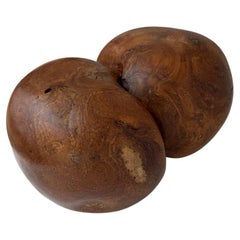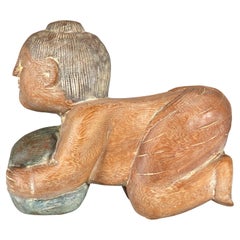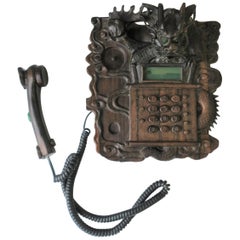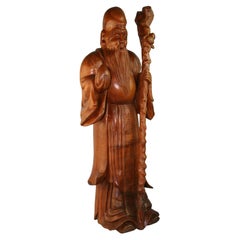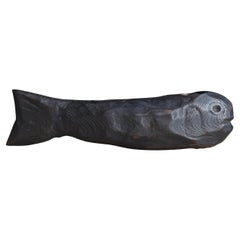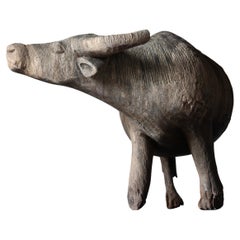Hardwood Sculptures and Carvings
2010s Organic Modern Hardwood Sculptures and Carvings
Wood, Teak, Reclaimed Wood
Mid-20th Century Asian Chinoiserie Hardwood Sculptures and Carvings
Wood, Padouk
Late 20th Century Chinese Hardwood Sculptures and Carvings
Jade
Early 1900s Antique Hardwood Sculptures and Carvings
Boxwood
Early 20th Century Japanese Meiji Hardwood Sculptures and Carvings
Chestnut
Early 20th Century Japanese Primitive Hardwood Sculptures and Carvings
Wood, Hardwood
Late 19th Century Chinese Qing Antique Hardwood Sculptures and Carvings
Hardwood
20th Century Indian Folk Art Hardwood Sculptures and Carvings
Hardwood
Early 20th Century Chinese Qing Hardwood Sculptures and Carvings
Jade
19th Century Thai Folk Art Antique Hardwood Sculptures and Carvings
Teak
20th Century Chinese Qing Hardwood Sculptures and Carvings
Jade
Early 20th Century Japanese Showa Hardwood Sculptures and Carvings
Bronze
21st Century and Contemporary Indonesian Organic Modern Hardwood Sculptures and Carvings
Teak
Early 20th Century Chinese Chinese Export Hardwood Sculptures and Carvings
Stone
Early 19th Century Victorian Antique Hardwood Sculptures and Carvings
Hardwood
15th Century and Earlier Chinese Antique Hardwood Sculptures and Carvings
Hardwood
Early 19th Century Japanese Antique Hardwood Sculptures and Carvings
Boxwood
1950s Vintage Hardwood Sculptures and Carvings
Boxwood
Early 20th Century Chinese Qing Hardwood Sculptures and Carvings
Lapis Lazuli
Late 19th Century Chinese Qing Antique Hardwood Sculptures and Carvings
Hardwood
20th Century Indian Other Hardwood Sculptures and Carvings
Hardwood
1940s Vintage Hardwood Sculptures and Carvings
Shell, Fruitwood
19th Century Indian Anglo Raj Antique Hardwood Sculptures and Carvings
Teak
20th Century Primitive Hardwood Sculptures and Carvings
Shell, Wood, Teak, Reclaimed Wood
Mid-20th Century Indonesian Hardwood Sculptures and Carvings
Hardwood
1970s Indonesian Other Vintage Hardwood Sculptures and Carvings
Teak
Early 20th Century Burmese Folk Art Hardwood Sculptures and Carvings
Teak
Early 19th Century Chinese Antique Hardwood Sculptures and Carvings
Wood, Elm
Early 1800s Thai Other Antique Hardwood Sculptures and Carvings
Teak
Late 19th Century Thai Antique Hardwood Sculptures and Carvings
Hardwood
Early 20th Century Japanese Hardwood Sculptures and Carvings
Boxwood
Early 20th Century Thai Country Hardwood Sculptures and Carvings
Hardwood, Giltwood, Paint
Mid-20th Century Indian Hardwood Sculptures and Carvings
Bone, Hardwood
18th Century Indian British Colonial Antique Hardwood Sculptures and Carvings
Teak
Early 20th Century Hardwood Sculptures and Carvings
Hardwood
Early 20th Century Chinese Qing Hardwood Sculptures and Carvings
Jade
Mid-20th Century Southeast Asian Tribal Hardwood Sculptures and Carvings
Teak
1930s Vintage Hardwood Sculptures and Carvings
Hardwood
Late 18th Century Chinese Qing Antique Hardwood Sculptures and Carvings
Boxwood
20th Century Chinese Hardwood Sculptures and Carvings
Jade
Late 19th Century Chinese Qing Antique Hardwood Sculptures and Carvings
Hardwood
Late 19th Century Indonesian Folk Art Antique Hardwood Sculptures and Carvings
Hardwood
Mid-19th Century Japanese Edo Antique Hardwood Sculptures and Carvings
Wood, Boxwood
19th Century Chinese Antique Hardwood Sculptures and Carvings
Hardwood
19th Century Indonesian Antique Hardwood Sculptures and Carvings
Teak
Late 19th Century Indian Antique Hardwood Sculptures and Carvings
Hardwood
2010s Organic Modern Hardwood Sculptures and Carvings
Metal
20th Century Chinese Chinese Export Hardwood Sculptures and Carvings
Hardwood
Early 20th Century Asian Anglo-Indian Hardwood Sculptures and Carvings
Teak
21st Century and Contemporary Indonesian Hardwood Sculptures and Carvings
Teak
Mid-20th Century Chinese Chinese Export Hardwood Sculptures and Carvings
Hardwood
2010s Organic Modern Hardwood Sculptures and Carvings
Metal, Steel
Mid-20th Century Thai Hardwood Sculptures and Carvings
Teak
21st Century and Contemporary Indonesian Hardwood Sculptures and Carvings
Teak
20th Century Chinese Hardwood Sculptures and Carvings
Hardwood
Early 20th Century Thai Hardwood Sculptures and Carvings
Teak
2010s Pakistani Hardwood Sculptures and Carvings
Wood, Bentwood, Ash
Late 18th Century Antique Hardwood Sculptures and Carvings
Hardwood
Early 20th Century Chinese Hardwood Sculptures and Carvings
Marble
Late 19th Century Thai Neoclassical Antique Hardwood Sculptures and Carvings
Gold Leaf, Metal
Read More
12 Calming Spaces Inspired by Japanese Design
From cherry-blossom-adorned walls paired with glamorous lighting to wood-paneled ceilings above checkerboard-patterned chairs, these 12 spaces seamlessly blend Eastern and Western aesthetics.
Rodrigo Rivero Lake’s Mexico City Showroom Is a Museum-Worthy Trove of Spanish Colonial and Asian Antiques
The dealer and curator has spent the past 50 years amassing a collection of exceptional art, furniture and architectural elements that trace the cultural influence of the Spanish empire from Europe to the Americas and beyond.
